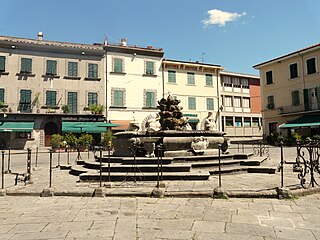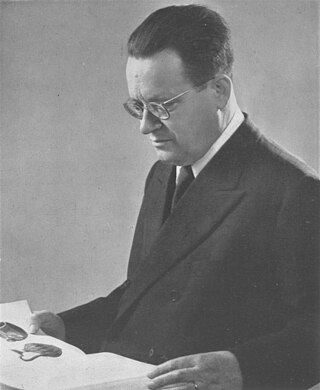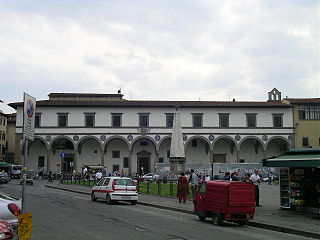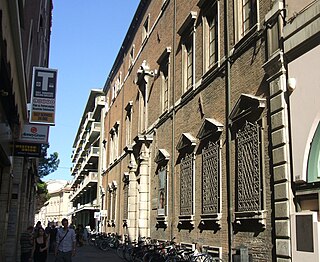
The province of Massa-Carrara is a province in the Tuscany region of Italy. It is named after the provincial capital Massa, and Carrara, the other main town in the province.
The following Esperanto libraries and collections of works in the Esperanto language are worthy of note:

Carrara is a town and comune in Tuscany, in central Italy, of the province of Massa and Carrara, and notable for the white or blue-grey marble quarried there. It is on the Carrione River, some 100 kilometres (62 mi) west-northwest of Florence. Its motto is Fortitudo mea in rota.

Fivizzano is a comune in the province of Massa and Carrara, Tuscany, central Italy.

Massa is a town and comune in Tuscany, central Italy, the administrative centre of the province of Massa and Carrara. It is located in the Frigido River Valley, near the Alpi Apuane, 5 km (3 mi) from the Tyrrhenian Sea.

Fosdinovo is a comune (municipality) in the Province of Massa and Carrara in the Italian region Tuscany, located about 110 kilometres (68 mi) northwest of Florence and about 15 kilometres (9 mi) northwest of Massa.

The National Central Library of Florence is a public national library in Florence, the largest in Italy and one of the most important in Europe, one of the two central libraries of Italy, along with the Biblioteca Nazionale Centrale di Roma.

The Orto Botanico delle Alpi Apuane "Pellegrini-Ansaldi", also known as the Orto Botanico di Pian della Fioba and, until 2016, Orto Botanico delle Alpi Apuane "Pietro Pellegrini", is a nature preserve and botanical garden located at 900 meters altitude in Pian della Fioba, Massa, Province of Massa-Carrara, Tuscany, Italy. It is operated by the town in collaboration with the Università della Toscana.

Bruno Migliorini was an Italian linguist and philologist. He was the author of one of the first scientific histories of Italian language and was president of the Accademia della Crusca.

The Biblioteca Comunale degli Intronati is the public library located at Via della Sapienza #3 of the comune of Siena, in Tuscany, Italy.

The Museo Nazionale Alinari della Fotografia, formerly Museo della Storia della Fotografia Fratelli Alinari is a photography museum located in part of the premises of the former Ospedale di San Paolo in the Piazza Santa Maria Novella in Florence, region of Tuscany, Italy). It hosts special exhibitions on a regular basis and possesses 350.000 vintage prints from the 19th and 20th centuries. The museum closed in 2012.

The Biblioteca Nazionale Braidense or Braidense National Library, usually known as the Biblioteca di Brera, is a public library in Milan, in northern Italy. It is one of the largest libraries in Italy. Initially, it contained large historical and scientific collections before it was charged with the legal deposit of all publications from Milan. Since 1880, it has had the status of a national library and is today one of the 47 Italian State libraries.

The Accademia di Belle Arti di Carrara is a public tertiary academy of art in Carrara, in Tuscany, Italy. It was founded on 26 September 1769 by Maria Teresa Cybo-Malaspina, duchess of Massa and princess of Carrara; but its origins go back to 1757, when, on the advice of the sculptor Giovanni Domenico Olivieri, she founded the Accademia di San Ceccardo in which sculpture, architecture and painting were to be taught. To house it, she commissioned Filippo del Medico to design and build a new building ; in 1807, by order of Elisa Bonaparte Baciocchi, the accademia was moved the Palazzo del Principe. The school of architecture was at first under Filippo del Medico; Giovanni Antonio Cybei was head of the school of sculpture.
The Zerasca is a breed of upland sheep from the province of Massa Carrara, in Tuscany in central Italy. It is raised almost exclusively in the comune of Zeri and the neighbouring comune of Pontremoli. In the years after the Second World War, systematic use was made of Massese rams with the aim of improving milk yield; the result was a reduction in resistance to disease and ability to forage on poor terrain, an increase in mammary defects, an increase in colour variability, but little improvement in milk yield. The Zerasca is one of the forty-two autochthonous local sheep breeds of limited distribution for which a herdbook is kept by the Associazione Nazionale della Pastorizia, the Italian national association of sheep-breeders.

San Francesco is a Romanesque and Gothic-style, Roman Catholic church located at Piazza San Francesco in Pescia, region of Tuscany, Italy.
The following is a timeline of the history of the city of Pistoia in the Tuscany region of Italy.
The following is a timeline of the history of the city of Prato in the Tuscany region of Italy.

The Biblioteca Civica Gambalunga, also known as the Gambalunghiana, is a public library in Rimini, in the region of Emilia-Romagna, northern Italy.

The Italian Esperanto Federation is a non-profit organisation that promotes the international auxiliary language Esperanto in Italy. It's headquartered in Milan.















